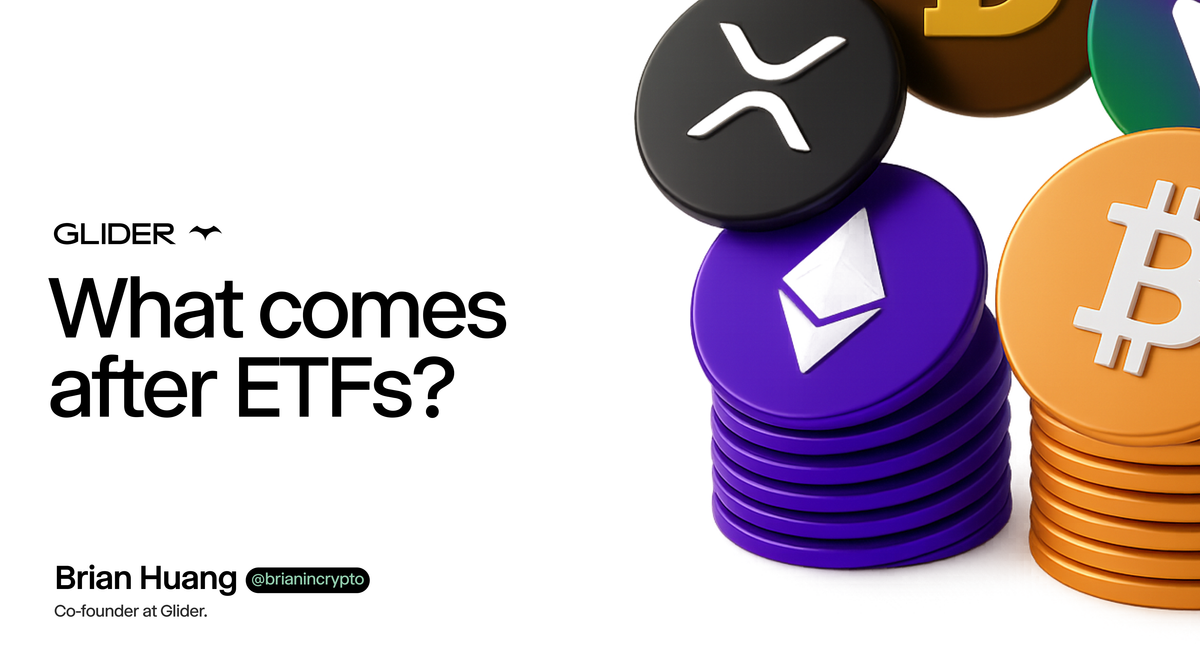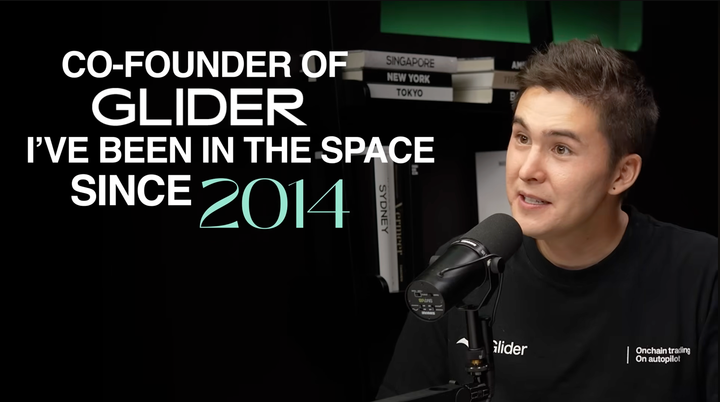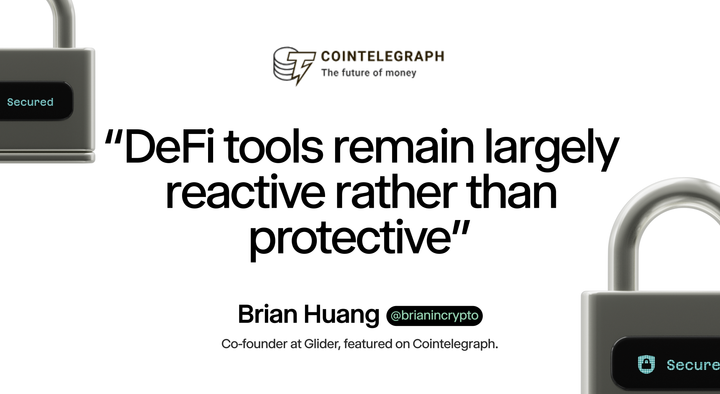The $15,000,000,000,000 Opportunity

Why ETFs Took Off – And Why Glider Makes Them Obsolete
— From Brian Huang, Co-Founder of Glider
tl;dr: The traditional finance (TradFi) construct of an ETF was a big leap forward from mutual funds, offering liquidity, transparency, and lower costs. On the other hand, while ETFs gave investors exposure, they created a convoluted system of rent-seeking middlemen and removed direct ownership.
In this piece, we explain why Glider's version of an ETF surpasses traditional ETFs: offering all of the conveniences of an ETF with the added benefits of being onchain. That means direct ownership of the underlying assets (no wrapper), real-time transparency, and the ability to personalize strategies instead of being locked into static exposure. While ETFs are only the tip of the iceberg for Glider, we like to use the ETF-example as a clear parallel for TradFi investors who are newer to decentralized finance (DeFi).
Ultimately, investing with Glider should feel as simple as investing with a TradFi brokerage, but with all the advantages of crypto: lower costs, no intermediaries, and instant settlement. The next leap forward belongs to programmable portfolios, and that’s the future we're building for at Glider.
A Brief History of ETFs
Exchange-Traded Funds (ETFs: baskets of assets that trade on stock exchanges like a single stock) first appeared in 1989 with the launch of the Toronto Index Participation Fund (TIPs). The real breakthrough, however, came in 1993 with the SPDR S&P 500 ETF (SPY), which for the first time gave investors intraday exposure to the S&P 500. Investors could now buy and sell that exposure throughout the trading day, something mutual funds never allowed.
The success of SPY proved the model: ETFs combined liquidity, transparency, and lower fees, and quickly grew across asset classes. Through the 2000s, ETFs expanded beyond equities into bonds, commodities, and international markets, with providers like iShares (later acquired by BlackRock) and Vanguard driving adoption. In 2004, SPDR Gold Shares (GLD) brought gold into ETF format, making the asset more accessible than ever.
By the 2010s, ETFs had gone mainstream. After the 2008 financial crisis, investors piled into ETFs for their transparency and low costs, favoring them over traditional active funds. Today, ETFs are a $15 trillion market globally and account for roughly 20% of US equity trading volumes.
Why ETFs Took Off
ETFs brought about accessibility and convenience:
- They trade like stocks, not just once per day like mutual funds.
- They’re transparent, with holdings disclosed daily.
- They’re lower cost than actively managed funds.
- They offer liquidity through creation/redemption.
- They provide diversification and access to new asset classes.
- They’re easy to use.
In short: ETFs democratized diversified investing.
Where ETFs Fall Short
The key shortfall of ETFs is no direct ownership. For stocks in particular, investors lose out on voting rights, tax-optimizations, and the ability to lend the underlying to short-sellers.
- No Voting Rights. Instead, BlackRock and Vanguard wield enormous voting power on behalf of investors.
- Inability to tax optimize. As a simple example, if you held all of the underlying stocks of the S&P 500 and half them gained and half of them lost on the year, you could keep the winners and sell the losers (locking in losses for taxes). Ultra-wealthy investors typically do not buy ETFs because they can replicate the index and take advantage of these potential losses.
- No lending to short-sellers. If you weren't aware, you can lend your stocks to short-seller to earn yield. For the vast majority of stocks these are <1% annualized, but for hard-to-borrow stocks investors can earn upwards of 20%.
Then there are the more hidden consequences of ETFs:
- Liquidity. While major ETFs like SPY are super liquid, smaller ETFs can struggle with liquidity. That liqudity can often be worse than the underlying stock liquidity.
- Lack of Customization. Investors can only choose from the selection of ETFs that BlackRock, Vanguard, and other ETF issuers create. If you did not want to hold 10 particular stocks in the S&P 500, there is no ETF for the S&P 490 and no way for an individual to create one.
- Tracking Error. The price of the ETF can deviate from the underlying basket by a few basis points (bps) a year to more meaningful amounts for less liquid ETFs.
- Fees. Usually between 2 bps to 10 bps, but there are outliers like the Grayscale Bitcoin ETF (GBTC) that charges an absurd 150 bps.
These shortfalls are not to say ETFs are poor by design. They have opened up an accessible diversification product for investors. In fact, many of these problems are not intrinsic to ETFs, but are caused by the inefficiencies of TradFi rails.
Glider’s Difference
First, what is Glider? Glider is a platform that allows anyone to create custom portfolios onchain. As a simple example, an investor can create a 50% bitcoin and 50% ethereum portfolio that will rebalance at any time interval (once a day, once a month, etc). The tokens and weightings are fully custom: include any onchain token and pick equal weighting, specified weightings, or market cap weighting.
Today, the overwhelming share of assets onchain are cryptocurrencies like bitcoin, but we are seeing the beginnings of onchain stocks, real world assets (RWAs), an tokenized private credit. Stablecoins (tokenized dollars) is really just the tip of the iceberg for what's to come. And that means that Glider portfolios will soon encompass all of these new onchain assets.
While Glider can do far more than create ETF-like structures, we'll focus here on why Glider does ETFs better than TradFi. First, let's consider why ETFs took off and how Glider still fulfills all of these conveniences:
- They trade like stocks, not just once per day like mutual funds ➡️
- With Glider buying a portfolio is 1-click.
- They’re transparent, with holdings disclosed daily ➡️
- All assets are on public ledgers (blockchains). Full transparency 24/7.
- They’re lower cost than actively managed funds ➡️
- There are no issuers for Glider portfolios. Nothing sitting between you and your assets. No BlackRock or Vanguard to pay.
- They offer liquidity through creation/redemption ➡️
- Holding the underlying means you tap into the deep liquidity of bitcoin, ethereum or any onchain asset.
- They provide diversification and access to new asset classes ➡️
- Diversification built-in. Create any basket of onchain assets.
- They’re easy to use ➡️
- We've abstracted away the complexities of DeFi to make Glider feel like a traditional brokerage. No mention of gas, signing, or bridging—and if you don't know what those mean, you shouldn't have to!
Glider portfolios are equally as convenient and even more transparent than traditional ETFs. So now how does Glider solve for the ineffiencies of ETFs. Again, using the same list as above:
- Voting Rights ➡️ With Glider this goes beyond just getting voting rights. Yes, owning the underlying gives you governance rights for those tokens, but it also gives you the rights to other utility for those tokens: lending, staking, and claiming rewards like airdrops.
- Tax optimize ➡️ Holding the underlying means you can keep the winners and sell the losers. Copy the same tax strategy the ultra-wealthy are doing in their portfolios.
- Lending to short-sellers ➡️ Most major cryptocurrencies and soon onchain stocks will have lending markets. Investors can now earn yield on top of their holdings. You only get this functionality when you own the underlying. For those of you who are more crypto-centric, a lending protocol is never going to accept a random tokenized ETF as collateral.
- Liquidity ➡️ This has been a huge problem for all existing onchain ETFs because they tokenize the ETF. And that's not the right approach. Holding the underlying means you tap into the liquidity of the underlying.
- Customization ➡️ With Glider, you can choose the onchain assets and weights and change them at any time. Share your portfolios with friends or browse our explore page for ideas.
- No Tracking Error ➡️ Simply put, there's no tracking error when you hold the underlying.
- Fees ➡️ No middlemen, means there is nothing between you and your assets. We no longer need issuers who charge annual fees.
Glider takes the same simplicity that made ETFs successful, but upgrades it for the onchain era.
With Glider, investing should feel as simple as using a brokerage account, but with portfolios that are programmable, sovereign, and built to last.
Why This All Matters
Some attempts to bring ETFs onchain — from tokenized ETFs to vault strategies — replicate the wrapper and miss the point. They still don’t solve the structural flaws of ETFs: exposure without ownership, rigidity instead of adaptability, and middlemen in between.
The bigger opportunity is not to copy ETFs, but to surpass them entirely.
ETFs democratized investing for the 1990s. Onchain portfolios will do the same for the 2020s, but with lower costs, greater flexibility, and true sovereignty over your assets.
And with $15 trillion already sitting in ETFs today, the scale of what’s possible is clear.
— Brian 🦇♾️



